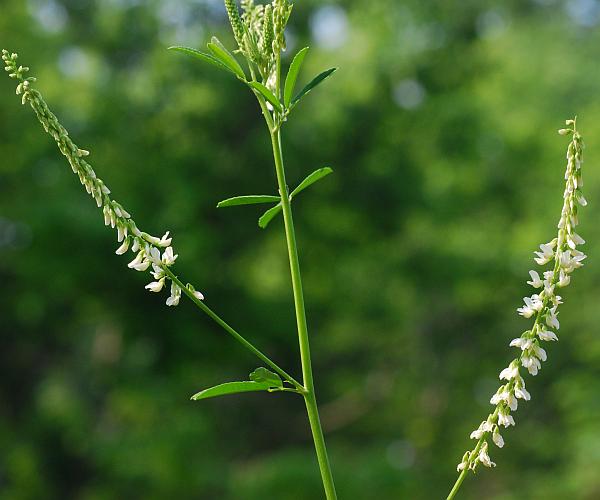Melilotus albus Medik.
White Sweet Clover

Introduced
CC = *
CW = 3
MOC = 71
© SRTurner
Melilotus albus Medik.White Sweet Clover | |
 |
Introduced CC = * CW = 3 MOC = 71 |
© SRTurner |
|
Family - Fabaceae/Faboideae Habit - Annual or biennial forb with stout taproot. Stems - Ascending to erect, to 2 m, angled, branched, glabrous or with a few sparse hairs. Leaves - Alternate, trifoliate, stipulate. Petioles 1-2 cm long, the terminal leaflet with the stalk 2-6 mm long. Stipules linear, 5-9 mm long. Leaflets oblanceolate to obovate, oblong-elliptic, 10-30 mm long, 4-17 mm wide, angled or slightly tapered at the base, rounded at the tip, the midvein usually extended as a minute, sharp point at the very tip, the margins sharply and finely toothed, the upper surface glabrous, the undersurface moderately pubescent with fine, appressed hairs, the venation pinnate, the secondary veins ending in the teeth.
Inflorescences - Axillary, elongate, spikelike racemes 4-14 cm long, becoming elongated at fruiting, the stalk 1-5 cm long, with numerous flowers, the stalks mostly longer than the subtending leaves, the bracts 0.8-1.5 mm long, linear. Flower stalks 0.5-2.0 mm long, downward-curved. Axis sparsely pubescent.
Flowers - Calyces glabrous or finely hairy, 1.5-2.2 mm long, the tube about as long as to slightly longer than the lobes, bell-shaped, the 5 lobes similar, triangular to narrowly triangular. Corollas papilionaceous, white, the banner 3.5-5.0 mm long, 2.0-2.2 mm wide, slightly longer than the wings and keel, the expanded portion obovate to oblong-obovate, narrowed to a short, stout, stalklike basal portion (this sometimes nearly absent), shallowly notched at the tip, curved or bent upward from about the midpoint, the wings slightly shorter than to about as long as the banner, with a stout, stalklike base, the expanded portion asymmetrically oblong to oblong-obovate, with a prominent auricle on 1 side, the keel about as long as the wings and more or less fused with them below the midpoint, boat-shaped, only slightly curved upward, rounded to bluntly pointed at the tip. Stamens 10, all of similar lengths, 9 of the filaments fused and 1 free to the base or nearly so, the fused portion usually much longer than the free portion, often oblique at the tip, the anthers relatively small, attached toward the base, yellow. Ovary short, sessile or very short-stalked, the style slender, usually longer than the ovary, glabrous, the stigma small and terminal.
Flowering - May - October. Fruits - Modified legumes 2.5-4.0 mm long, ovoid, slightly flattened, sessile or nearly so, the surfaces with a network of raised nerves.
Habitat - Upland prairies, glades, bluffs, streambanks, pond margins, pastures, fields, levees, lawns, railroads, roadsides, open disturbed areas. Origin - Native to Eurasia. Lookalikes - None. Other info. - This plant is common across most of Missouri and the entire continental U.S. It is easily recognized by its bushy, branched habit, trifoliate leaves, and numerous racemes of small, white flowers. Photographs taken at Shaw Nature Reserve, Franklin County, MO, 5-29-2007, Busch Wildlife Area, St. Charles County, MO, 6-12-2009, and on the Katy Trail near Dutzow, Warren County, MO, 7-1-2020 and 7-12-2022 (SRTurner). |